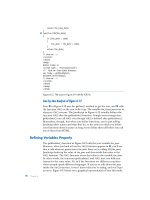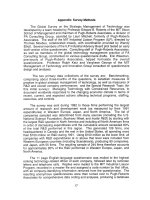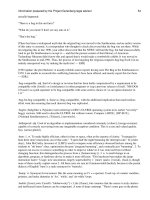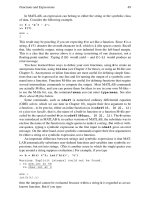The CISSP Prep Guide, Second Edition Mastering the CISSP and ISSEP Exams phần 3 doc
Bạn đang xem bản rút gọn của tài liệu. Xem và tải ngay bản đầy đủ của tài liệu tại đây (2.01 MB, 106 trang )
55915X Ch03.qxd 3/22/04 5:46 PM Page 179
Chapter 3 ✦ Telecommunications and Network Security
179
TCP SYN (half open) scanning. TCP SYN scanning is often referred to as half-
open scanning because, unlike TCP connect( ), a full TCP connection is never
opened. The scan works by:
1. Sending a SYN packet to a target port.
2. If a SYN/ACK is received this indicates the port is listening.
3. The scanner then breaks the connection by sending an RST (reset)
packet.
4. If an RST is received, this indicates the port is closed.
This is harder to trace because fewer sites log incomplete TCP connections,
but some packet-filtering firewalls look for SYNs to restricted ports.
TCP SYN/ACK scan. TCP SYN/ACK is another way to determine if ports are
open or closed. The TCP SYN/ACK scan works by:
• Scanner initially sends a SYN/ACK.
• If the port is closed, it assumes the SYN/ACK packet was a mistake and
sends an RST.
• If the port was open, the SYN/ACK packet will be ignored and drop the
packet.
This is considered a stealth scan since it isn’t likely to be logged by the host
being scanned, but many intrusion detection systems may catch it.
TCP FIN scanning. TCP FIN is a stealth scan that works like the TCP SYN/ACK
scan.
• Scanner sends a FIN packet to a port.
• A closed port replies with an RST.
• An open port ignores the FIN packet.
One issue with this type of scanning is that TCP FIN can be used only to find
listening ports on non-Windows machines or to identify Windows machines
because Windows ports send an RST regardless of the state of the port.
TCP ftp proxy (bounce attack) scanning. TCP FTP proxy (bounce attack)
scanning is a very stealthy scanning technique. It takes advantage of a weak-
ness in proxy ftp connections. It works like this:
• The scanner connects to an FTP server and requests that the server ini-
tiate a data transfer process to a third system.
• The scanner uses the PORT FTP command to declare that the data trans-
fer process is listening on the target box at a certain port number.
55915X Ch03.qxd 3/22/04 5:46 PM Page 180
180
Part I ✦ Focused Review of the CISSP Ten Domains
• It then uses the LIST FTP command to try to list the current directory.
The result is sent over the server data transfer process channel.
• If the transfer is successful, the target host is listening on the specified
port.
• If the transfer is unsuccessful, a “425 Can’t build data connection:
Connection refused” message is sent.
Some FTP servers disable the proxy feature to prevent TCP FTP proxy
scanning.
IP fragments. Fragmenting IP packets is a variation on the other TCP scanning
techniques. Instead of sending a single probe packet, the packet is broken into
two or more packets and reassembled at the destination, thus bypassing the
packet filters.
ICMP scanning (ping sweep). As ICMP doesn’t use ports, this is technically
not a port scanning technique, but it should be mentioned. Using ICMP Echo
requests, the scanner can perform what is known as a ping sweep. Scanned
hosts will reply with an ICMP Echo reply indicating that they are alive,
whereas no response may mean the target is down or nonexistent.
Determining the OS Type
Determining the type of OS is also an objective of scanning, as this will determine
the type of attack to be launched.
Sometimes a target’s operating system details can be found very simply by examin-
ing its Telnet banners or its File Transfer Protocol (FTP) servers, after connecting to
these services.
TCP/IP stack fingerprinting is another technique to identify the particular version of
an operating system. Since OS and device vendors implement TCP/IP differently,
these differences can help in determining the OS.
Some of these differences include:
✦ Time To Live (TTL)
✦ Initial Window Size
✦ Don’t Fragment (DF) bit
✦ Type of Service (TOS)
Table 3-11shows some common Time To Live values. Remember that the TTL will
decrement each time the packet passes through a router. This means that the TTL
of a router 6 hops away will be 249 (255 – 6).
Another type of OS identification technique is TCP initial sequence number sampling.
After responding to a connection request, information about the operating system
can be inferred from the pattern of the sequence numbers.
55915X Ch03.qxd 3/22/04 5:46 PM Page 181
Chapter 3 ✦ Telecommunications and Network Security
181
Table 3-11
Time To Live (TTL) Values
Time To Live Operating System or Device Type
255 Many network devices, Unix and Macintosh systems
128 Many Windows systems
60 Hewlett-Packard Jet Direct printers
32 Some versions of Windows 95B/98
Scanning Tools
While many of these tools are used by crackers and intruders, they also help the
security administrator detect and stop malicious scans. Used with intrusion detec-
tion systems, these tools can provide some level of protection by identifying vulner-
able systems, and they can provide data about the level of activity directed against
a machine or network. Since scanning is a continuous activity (that is, all net-
worked systems are being scanned all of the time), it’s very important that the
security professional know what can be compromised. Some common scanning
tools are:
✦ Computer Oracle and Password System (COPS) — examines a system for a num-
ber of known weaknesses and alerts the administrator.
✦ HPing — a network analysis tool that sends packets with non-traditional IP
stack parameters. It allows the scanner to gather information from the
response packets generated.
✦ Legion — will scan for and identify shared folders on scanned systems, allow-
ing the scanner to map drives directly.
✦ Nessus — a free security-auditing tool for Linux, BSD, and a few other plat-
forms. It requires a back-end server that has to run on a Unix-like platform.
✦ NMap — a very common port-scanning package. More information on NMap
follows this section.
✦ Remote Access Perimeter Scanner (RAPS) — part of the corporate edition of
PCAnywhere by Symantec. RAPS will detect most commercial remote control
and backdoor packages like NetBus, and it can help lockdown PCAnywhere.
✦ Security Administrator’s Integrated Network Tool (SAINT) — examines network
services, such as finger, NFS, NIS, ftp and tftp, rexd, statd, and others, to
report on potential security flaws.
✦ System Administrator Tool for Analyzing Networks (SATAN ) — is one of the old-
est network security analyzers. SATAN scans network systems for well known
and often exploited vulnerabilities.
55915X Ch03.qxd 3/22/04 5:46 PM Page 182
182
Part I ✦ Focused Review of the CISSP Ten Domains
✦ Tcpview — will allow identification of what application opened which port on
Windows platforms.
✦ Snort — is a utility used for network sniffing. Network sniffing is the process of
gathering traffic from a network by capturing the data as it passes and storing
it to analyze later.
NMap
NMap scans for most ports from 1–1024 and a number of others in the registered
and undefined ranges. This helps identify software like PCAnywhere, SubSeven, and
BackOrifice. Now that a Windows interface has been written, it no longer has to be
run only on a Unix system.
NMap allows scanning of both TCP and UDP ports, with root privilege required for
UDP. While NMap doesn’t have signature or password cracking capabilities, like
L0pht Crack, it will estimate how hard it will be to hijack an open session.
Vulnerable Ports
Although the complete listing of well-known and registered ports is extensive, some
ports are attacked more often than others. In Table 3-12, we’ve listed the ports that
are the greatest risk to networked systems.
Table 3-12
Commonly Attacked Ports
Port # Service Name Service Description
21 ftp File Transfer Protocol
23 telnet Telnet virtual terminal
25,109,110 143 smtp pop3 imap Simple Mail Protocol, POP2, POP3 and
IMAP Messaging
53 dns Domain Name Services
80, 8000, 8080 http Hyper-Text Transfer Protocol and HTTP
proxy servers
118 sqlserv SQL database service
119 nntp Network News Transfer Protocol
161 snmp Simple Network Management Protocol
194 irc Internet Relay Chat
389,636 ldap Lightweight Directory Access Protocol
2049 nfs Networking File Systems
5631 PCAnywhere PCAnywhere Remote Control
55915X Ch03.qxd 3/22/04 5:46 PM Page 183
Chapter 3 ✦ Telecommunications and Network Security
183
tory must be deleted after creation of an rdisk. Pwdump and pwdump2 are utilities that
allow someone with Administrator rights to target the Local Security Authority Subsystem,
isass.exe, from a remote system:
✦ Obtain the backup SAM from the repair directory
✦ Boot the NT server with a floppy containing an alternate operating system
✦
How Do We Get Windows NT Passwords?
The NT Security Accounts Manager (SAM) contains the usernames and encrypted pass-
words of all local (and domain, if the server is a domain controller) users. The SAM uses an
older, weaker LanManager hash that can be broken easily by tools like L0phtcrack. Physical
access to the NT server and the rdisks must be controlled. The “Sam” file in the repair direc-
Use pwdump2 to dump the password hashes directly from the registry
Issues with Vulnerability Scanning
Some precautions need to be taken when the security administrator begins a pro-
gram of vulnerability scanning on his or her own network. Some of these issues
could cause a system crash or create unreliable scan data:
False positives. Some legitimate software uses port numbers registered to
other software, which can cause false alarms when port scanning. This can
lead to blocking legitimate programs that appear to be intrusions.
Heavy traffic. Port scanning can have an adverse effect on WAN links and
even effectively disable slow links. Because heavy port scanning generates a
lot of traffic, it is usually preferable to perform the scanning outside normal
business hours.
False negatives. Port scanning can sometimes exhaust resources on the
scanning machine, creating false negatives and not properly identifying
vulnerabilities.
System crash. Port scanning has been known to render needed services inop-
erable or actually crash systems. This may happen when systems have not
been currently patched or the scanning process exhausts the targeted sys-
tem’s resources.
Unregistered port numbers. Many port numbers in use are not registered,
which complicates the act of identifying what software is using them.
Malicious Code
Malicious code is the name used for any program that adds to, deletes or modifies
legitimate software for the purpose of intentionally causing disruption and harm or
to circumvent or subvert the existing system’s function. Examples of malicious
55915X Ch03.qxd 3/22/04 5:46 PM Page 184
184
Part I ✦ Focused Review of the CISSP Ten Domains
code include viruses, worms, Trojan Horses, and logic bombs. Newer malicious
code is based on mobile Active X and Java applets.
Viruses
Viruses are a type of malicious code that attaches to a host program and propa-
gates when an infected program is executed.
A virus infects the operating system in two ways: by completely replacing one or
more of the operating system’s programs or by attaching itself to existing operating
system’s programs and altering functionality. Once a virus has changed OS func-
tionality, it can control many OS processes that are running.
To avoid detection, the virus usually creates several hidden files within the OS
source code or in “unusable” sectors. Since infections in the OS are difficult to
detect, they have deadly consequences on systems relying on the OS for basic
functions.
The Virus Lifecycle
There are two main phases in the life cycle of a virus: replication and activation. In
the first phase, replication, viruses typically remain hidden and do not interfere
with normal system functions. During this time, viruses actively seek out new hosts
to infect by attaching themselves to other software programs or by infiltrating the
OS, for example.
During the second phase, activation, the beginning of gradual or sudden destruc-
tion of the system occurs. Typically, the decision to activate is based on a mathe-
matical formula with criteria such as date, time, number of infected files, and
others. The possible damage at this stage could include destroyed data, software or
hardware conflicts, space consumption, and abnormal behavior.
Macro Viruses
Macro viruses are the most prevalent computer viruses in the wild, accounting for
the vast majority of virus encounters. A macro virus can easily infect many types of
applications, such as Microsoft Excel and Word.
To infect the system, macro viruses attach themselves to the application’s initializa-
tion sequence, and then when the application is executed, the virus’s instructions
execute before control is given to the application. Then the virus replicates itself,
infecting more and more of the system.
These macro viruses move from system to system through email file sharing,
demonstrations, data sharing, and disk sharing. Today’s widespread sharing of
macro-enabled files, primarily through email attachments, is rapidly increasing the
macro virus threat.
55915X Ch03.qxd 3/22/04 5:46 PM Page 185
Chapter 3 ✦ Telecommunications and Network Security
185
Common macro viruses are:
✦ Executable files infecting the boot sector: Jerusalem, Cascade, Form
✦ Word macros: Concept
✦ Email enabled Word macros: Melissa
✦ Email enabled Visual Basic scripts: I Love You
Polymorphic Viruses
Polymorphic viruses are difficult to detect because they hide themselves from
antivirus software by altering their appearance after each infection. Some polymor-
phic viruses can assume over two billion different identities.
There are three main components of a polymorphic virus: a scrambled virus body,
a decryption routine, and a mutation engine. The process of a polymorphic infec-
tion is:
1. The decryption routine first gains control of the computer and then decrypts
both the virus body and the mutation engine.
2. The decryption routine transfers control of the computer to the virus, which
locates a new program to infect.
3. The virus makes a copy of itself and the mutation engine in RAM.
4. The virus invokes the mutation engine, which randomly generates a new
decryption routine capable of decrypting the virus yet bearing little or no
resemblance to any prior decryption routine.
5. The virus encrypts the new copy of the virus body and mutation engine.
6. The virus appends the new decryption routine, along with the newly
encrypted virus and mutation engine, onto a new program.
As a result, not only is the virus body encrypted, but also the virus decryption rou-
tine varies from infection to infection. No two infections look alike, confusing the
virus scanner searching for the sequence of bytes that identifies a specific decryp-
tion routine.
Stealth Viruses
Stealth viruses attempt to hide their presence from both the OS and the antivirus
software by:
✦ Hiding the change in the file’s date and time
✦ Hiding the increase in the infected file’s size
✦ Encrypting themselves
They are similar to polymorphic viruses in that they are very hard to detect.
55915X Ch03.qxd 3/22/04 5:46 PM Page 186
186
Part I ✦ Focused Review of the CISSP Ten Domains
Trojan Horses
Trojan horses hide malicious code inside a host program that seems to do some-
thing useful. Once these programs are executed, the virus, worm, or other type of
malicious code hidden in the Trojan horse program is released to attack the work-
station, server, or network or to allow unauthorized access to those devices.
Trojans are common tools used to create backdoors into the network for later
exploitation by crackers.
Trojan horses can be carried via Internet traffic such as FTP downloads or down-
loadable applets from Web sites, or they can be distributed through email.
Common Trojan horses and ports are:
✦ Trinoo — ports 1524, 27444, 27665, 31335
✦ Back Orifice or BO2K — port 31337
✦ NetBus — port 12345
✦ SubSeven — ports 1080, 1234, 2773
Some Trojans are programmed to open specific ports to allow access for exploita-
tion. If a Trojan is installed on a system it often opens a high-numbered port. Then
the open Trojan port could be scanned and located, enabling an attacker to com-
promise the system.
Logic Bombs
Logic bombs are malicious code added to an existing application to be executed at
a later date. Every time the infected application is run, the logic bomb checks the
date to see whether it is time to run the bomb. If not, control is passed back to the
main application and the logic bomb waits. If the date condition is correct, the rest
of the logic bomb’s code is executed, and it can attack the system.
In addition to the date, there are numerous ways to trigger logic bombs: counter
triggers; replication triggers, which activate after a set number of virus reproduc-
tions; disk space triggers; and video mode triggers, which activate when video is in
a set mode or changes from set modes.
Worms
Instead of attaching themselves to a single host program and then replicating like
viruses, worms attack a network by moving from device to device. Worms are con-
structed to infiltrate legitimate data processing programs and alter or destroy the
data.
55915X Ch03.qxd 3/22/04 5:46 PM Page 187
Chapter 3 ✦ Telecommunications and Network Security
187
Malicious Code Prevention
Malicious code prevention is mostly centered on scanning, prevention, and detec-
tion products.
Virus Scanners
Most virus scanners use pattern-matching algorithms that can scan for many differ-
ent signatures at the same time. These algorithms include scanning capabilities that
detect known and unknown worms and Trojan horses.
Most antivirus scanning products search hard disks for viruses, detect and remove
any that are found, and include an auto-update feature that enables the program
to download profiles of new viruses so that it will have the profiles necessary for
scanning.
Virus Prevention
Virus infection prevention products are used to prevent malicious code from ini-
tially infecting the system and stop the replication process. They either reside in
memory and monitor system activity or filter incoming executable programs and
specific file types. When an illegal virus accesses a program or boot sector, the sys-
tem is halted and the user is prompted to remove the particular type of malicious
code.
Virus Detection
Virus detection products are designed to detect a malicious code infection after the
infection occurs. Two types of virus detection products are commonly imple-
mented: short-term infection detection and long-term infection detection. Short-
term infection detection products detect an infection very soon after the infection
has occurred. Short-term infection detection products can be implemented through
vaccination programs or the snapshot technique.
Long-term infection detection products identify specific malicious code on a system
that has already been infected for some time. The two different techniques used by
long-term infection detection products are spectral analysis and heuristic analysis.
Spectral analysis searches for patterns in the code trails that malicious code leaves.
Heuristic analysis analyzes malicious code to figure out its capability.
Web Security
With the transformation of the Internet from a network used primarily by universi-
ties and research laboratories to a world-wide communications medium, attacks on
the World Wide Web and Internet can have serious consequences. These attacks
55915X Ch03.qxd 3/22/04 5:46 PM Page 188
188
Part I ✦ Focused Review of the CISSP Ten Domains
can involve nuisance attacks, criminal exploits and, in information warfare, incapac-
itation of a nation’s critical infrastructure. Thus, there is a need for protecting
nodes on the Internet and for providing for the confidentiality, integrity, and avail-
ability of information utilizing these networks.
SSL/TLS
The Secure Sockets Layer (SSL) Protocol was developed by Netscape in 1994 to pro-
tect the confidentiality of information transmitted between two applications, to ver-
ify the integrity of the communications, and to provide an authentication means in
both directions. SSL implements these functions using public and private key
encryption and a message authentication code (MAC).
Microsoft has developed a newer version of SSL, Transport Layer Security (TLS). As
with SSL, TLS implements confidentiality, integrity, and authentication above the
Transport Layer and is application independent. Because SSL and TLS ride on the
Transport Layer protocol, they are independent of the application. Thus, SSL and
TLS can be used with applications such as Telnet, FTP, HTTP, and email protocols.
Both SSL and TLS use certificates for public key verification that are based on the
X.509 standard.
SSL 3.0
The design goals of SSL 3.0 were to provide:
✦ Cryptographic security — protection of the confidentiality of transmitted mes-
sages.
✦ Interoperability — applications should be able to be developed using SSL 3.0
by groups of individuals without knowledge of each other’s code.
✦ Extensibility — the ability to incorporate different encryption algorithms into
SSL 3.0 without major changes to SSL 3.0.
✦ Relative efficiency — efficient utilization of computing and network resources.
Session keys generated during SSL private key cryptography transactions are either
40-bits or 128-bits in length. Newer browsers support 128-bit encryption.
The SSL Protocol comprises two layers, the SSL Record Protocol and the SSL
Handshake Protocol. The SSL Record Protocol is layered above a transport proto-
col, such as TCP. This Record Protocol is used for encapsulation of higher-level pro-
tocols, such as the SSL Handshake Protocol. The latter protocol is used for
client/server mutual authentication, negotiation of a cryptographic algorithm, and
exchange of cryptographic keys.
55915X Ch03.qxd 3/22/04 5:46 PM Page 189
Chapter 3 ✦ Telecommunications and Network Security
189
Thus, through these mechanisms, SSL provides:
✦ Mutual authentication using pubic key cryptography based on algorithms
such as the Digital Signature Standard (DSS) and RSA
✦ Encryption of messages using private key cryptography based on algorithms
such as IDEA, 3DES, and RC4
✦ Integrity verification of the message using a keyed message authentication
code (MAC) based on hash functions such as MD5 and SHA.
TLS 1.0
Similar to SSL, the TLS Protocol is comprised of the TLS Record and Handshake
Protocols. The TLS Record Protocol is layered on top of a transport protocol such
as TCP and provides privacy and reliability to the communications. The privacy is
implemented by encryption using symmetric key cryptography such as DES or RC4.
The secret key is generated anew for each connection; however, the Record Protocol
can be used without encryption. Integrity is provided through the use of a keyed
Message Authentication Code (MAC) using hash algorithms such as SHA or MD5.
The TLS Record Protocol is also used to encapsulate a higher-level protocol such as
the TLS Handshake Protocol. The server and client use this Handshake Protocol to
authenticate each other. The authentication can be accomplished using asymmetric
key cryptography such as RSA or DSS. The Handshake Protocol also sets up the
encryption algorithm and cryptographic keys to enable the application protocol to
transmit and receive information.
Since TLS is based on SSL, they have similar functionality and goals; however, SSL
and TLS have enough differences that they cannot interoperate. In order to address
this situation, TLS has a built-in mechanism that can be used to make TLS compati-
ble with SSL 3.0.
S-HTTP
Secure HTTP (S-HTTP) is a communications protocol designed to provide secure
messaging over HTTP. S-HTTP provides equal and symmetric capabilities to both
client and server, but one entity that is S-HTTP-enabled can communicate with
another entity that is not S-HTTP capable. In that instance, the security features
would not be operable. S-HTTP implements secure, end-to-end transactions.
Protocol with SSL.
HTTP/S
Web pages using the SSL Protocol start with HTTPs, denoting the Hypertext Transfer
55915X Ch03.qxd 3/22/04 5:46 PM Page 190
190
Part I ✦ Focused Review of the CISSP Ten Domains
S-HTTP supports a symmetric key encryption only mode and, therefore, does not
require public key encryption for key exchanges. It is flexible, however, and permits
the clients and servers to use different forms of transactions related to the signing
of messages, encryption of messages, algorithms used, and types of certificates.
In summary, S-HTTP is a protocol that supports:
✦ Option negotiations for defining the type of transactions desired
✦ A variety of key management approaches
✦ Different trust models
✦ Multiple cryptographic algorithms
✦ Multiple operation modes
✦ Different encapsulation formats
Instant Messaging
Instant messaging goes a step beyond email in that it supports the real time
exchange of messages between two parties using the Internet. In order to use this
service, the user has to have instant messaging client software on his or her com-
puter. The client software then communicates with an instant messaging server.
The user provides the server with a contact or “buddy” list of people with which he
or she desires to set up instant messaging.
To use instant messaging, the user logs on to the instant messaging server with the
user’s ID and password. The server authenticates the user. Then, the client sends to
the server the user’s IP address and the port number on the user’s computer that is
being used by the instant messaging client. The server stores this information as
well as identical information from any other individuals on the user’s contact list
that are logged in at that time. An important point to note is that once an individual,
A, is logged on to the server, the server sends the IP addresses and port numbers of
all the others logged on to the server at that time to A’s client software. Thus, all
people on the contact list who are logged on to the instant messaging server at that
time are notified of the online presence and contact information of the others who
are also logged on.
A user can send a message to another individual on the contact list who is logged
on and that message will instantly appear on the screen of the receiving individual.
Because a user’s client knows the IP address and port number of the receiving indi-
vidual, the user’s message is sent directly to the intended recipient and does not
have to go through the instant messaging server.
55915X Ch03.qxd 3/22/04 5:46 PM Page 191
Chapter 3 ✦ Telecommunications and Network Security
191
With instant messaging, communication takes place between only two individuals.
If the situation requires instant conferencing among more than two individuals, a
chat room can be set up. A chat room is similar to instant messaging, but everyone
logged on to the “room” can see a message that is sent by one individual.
When an individual, A, wants to terminate the instant messaging session, A closes
his or her message window and exits the instant messaging client. The client then
sends a message to the instant messaging server indicating that A has logged off.
The server, in turn, sends a message to all the active participants of the contact list
that A has exited the session. The members of the contact list still logged on will
see the status of A on their windows change from “online” to “offline.”
Instant messaging software packages also offer other services, including chat
rooms set up, image and sound transmission, voice communication, and streaming
content.
Some of the more popular instant messaging utilities are the freeware ICQ (for “I
seek you” at www.icq.com), AIM (America Online’s Instant Messenger), Microsoft’s
instant messaging utility in MSN Explorer, and Yahoo Instant Messenger.
One problem with instant messaging is the lack of interoperability. An individual
with an instant messaging utility from one source or vendor may not be able to
communicate with a person using a different instant messaging package. In order to
address this situation, the Internet Engineering Task Force (IETF) has developed a
standard protocol for instant messaging — the Instant Messaging Presence
Protocol.
IM Vulnerabilities
Messages sent by means of instant messaging are not inherently secure and safe
from prying eyes. The instant messaging server is particularly vulnerable because it
contains both the messages and the connection information of the participants.
Thus, instant messaging servers should be secure servers located in protected and
limited access areas. Additional security features that are provided by some instant
messaging software utilities include:
✦ Encryption, integrity, and authentication services using SSL
✦ Authentication against propriety databases, domains, or LDAP
✦ Secure transfer of files
✦ Ability to use any TCP port
✦ Web-based tools for administration of the instant messaging network on the
instant messaging server, including tools for user account administration, log-
ging of critical data, and analysis of log information
55915X Ch03.qxd 3/22/04 5:46 PM Page 192
192
Part I ✦ Focused Review of the CISSP Ten Domains
8.3 Naming Conventions
The Microsoft New Technology File System (NTFS) has the capability to generate
file names in the DOS 8.3 naming convention to service 16-bit applications that
access files that do not conform DOS 8.3 naming. Windows 2000, Windows NT
Server, and Windows NT Workstation support the NTFS file system. Windows 95
and 98 support the earlier File Allocation Table (FAT) file system along with the
newer version, FAT 32. The NTFS enhancements over FAT and FAT 32 include opti-
mization of available disk space, fault tolerance, and improved security features.
Web servers that respond to requests for files in their DOS 8.3 file names are vulner-
able to attacks that can cause the server to reveal source code. A fix to this prob-
lem is to disable DOS 8.3 file name creation on the NTFS server, but this may lead to
difficulties in using 16-bit applications.
✦ ✦ ✦
55915X Ch03.qxd 3/22/04 5:46 PM Page 193
193
Chapter 3 ✦ Study Guide
193
Assessment Questions
You can find the answers to the following questions in Appendix A.
1. Which choice below is NOT an element of a fiber optic cable?
a. Core
b. BNC
c. Jacket
d. Cladding
2. Which backup method listed below will probably require the backup operator
to use the most number of tapes for a complete system restoration if a differ-
ent tape is used every night in a five-day rotation?
a. Full
b. Differential
c. Incremental
d. Ad Hoc
3. To what does 10Base-5 refer?
a. 10 Mbps thinnet coax cabling rated to 185 meters maximum length
b. 10 Mbps thicknet coax cabling rated to 500 meters maximum length
c. 10 Mbps baseband optical fiber
d. 100 Mbps unshielded twisted pair cabling
4. Which LAN transmission method below describes a packet sent from a single
source to multiple specific destinations?
a. Unicast
b. Multicast
c. Broadcast
d. Anycast
5. Which part of the 48-bit, 12-digit hexadecimal number known as the Media
Access Control (MAC) address identifies the manufacturer of the network
device?
a. The first three bytes
b. The first two bytes
c. The second half of the MAC address
d. The last three bytes
55915X Ch03.qxd 3/22/04 5:46 PM Page 194
194
Chapter 3 ✦ Study Guide
6. Which choice below BEST describes coaxial cable?
a. Coax consists of two insulated wires wrapped around each other in a
regular spiral pattern.
b. Coax consists of a hollow outer cylindrical conductor surrounding a sin-
gle, inner conductor.
c. Coax does not require the fixed spacing between connections that UTP
requires.
d. Coax carries signals as light waves.
7. Which choice below is NOT one of the legal IP address ranges specified by
RFC1976 and reserved by the Internet Assigned Numbers Authority (IANA) for
nonroutable private addresses?
a. 10.0.0.0–10.255.255.255
b. 127.0.0.0–127.0.255.255
c. 172.16.0.0–172.31.255.255
d. 192.168.0.0–192.168.255.255
8. Which statement below about the difference between analog and digital sig-
nals is incorrect?
a. An analog signal produces an infinite waveform.
b. Analog signals cannot be used for data communications.
c. An analog signal can be varied by amplification.
d. A digital signal produces a saw-tooth waveform.
9. Which choice below most accurately describes SSL?
a. It’s a widely used standard of securing email at the Application level.
b. It gives a user remote access to a command prompt across a secure,
encrypted session.
c. It uses two protocols, the Authentication Header and the Encapsulating
Security Payload.
d. It allows an application to have authenticated, encrypted communica-
tions across a network.
10. Which IEEE protocol defines wireless transmission in the 5 GHz band with
data rates up to 54 Mbps?
a. IEEE 802.11a
b. IEEE 802.11b
c. IEEE 802.11g
d. IEEE 802.15
55915X Ch03.qxd 3/22/04 5:46 PM Page 195
195
Chapter 3 ✦ Study Guide
195
11. Which protocol is used to resolve a known IP address to an unknown MAC
address?
a. ARP
b. RARP
c. ICMP
d. TFTP
12. Which TCP/IP protocol operates at the OSI Network Layer?
a. FTP
b. IP
c. TCP
d. UDP
13. Which statement accurately describes the difference between 802.11b WLAN
ad hoc and infrastructure modes?
a. The ad hoc mode requires an Access Point to communicate to the wired
network.
b. Wireless nodes can communicate peer-to-peer in the infrastructure
mode.
c. Wireless nodes can communicate peer-to-peer in the ad hoc mode.
d. Access points are rarely used in 802.11b WLANs.
14. Which answer below is true about the difference between TCP and UDP?
a. UDP is considered a connectionless protocol and TCP is connection ori-
ented.
b. TCP is considered a connectionless protocol, and UDP is connection ori-
ented.
c. UDP acknowledges the receipt of packets, and TCP does not.
d. TCP is sometimes referred to as an unreliable protocol.
15. Which choice below denotes a packet-switched connectionless wide area net-
work (WAN) technology?
a. X.25
b. Frame Relay
c. SMDS
d. ATM
55915X Ch03.qxd 3/22/04 5:46 PM Page 196
196
Chapter 3 ✦ Study Guide
16. Which answer below is true about the difference between FTP and TFTP?
a. FTP does not have a directory-browsing capability, whereas TFTP does.
b. FTP enables print job spooling, whereas TFTP does not.
c. TFTP is less secure because session authentication does not occur.
d. FTP is less secure because session authentication does not occur.
17. Which statement below is correct regarding VLANs?
a. A VLAN restricts flooding to only those ports included in the VLAN.
b. A VLAN is a network segmented physically, not logically.
c. A VLAN is less secure when implemented in conjunction with private
port switching.
d. A closed VLAN configuration is the least secure VLAN configuration.
18. Which statement about a VPN tunnel below is incorrect?
a. It can be created by implementing only IPSec devices.
b. It can be created by installing software or hardware agents on the client
or network.
c. It can be created by implementing key and certificate exchange systems.
d. It can be created by implementing node authentication systems.
19. Which utility below can create a server-spoofing attack?
a. DNS poisoning
b. C2MYAZZ
c. Snort
d. BO2K
20. What is a server cluster?
a. A primary server that mirrors its data to a secondary server
b. A group of independent servers that are managed as a single system
c. A tape array backup implementation
d. A group of WORM optical jukeboxes
21. Which attack type below does NOT exploit TCP vulnerabilities?
a. Sequence Number attack
b. SYN attack
c. Ping of Death
d. land.c attack
55915X Ch03.qxd 3/22/04 5:46 PM Page 197
197
Chapter 3 ✦ Study Guide
197
22. What is probing used for?
a. To induce a user into taking an incorrect action
b. To give an attacker a road map of the network
c. To use up all of a target’s resources
d. To covertly listen to transmissions
23. Which firewall type below uses a dynamic state table to inspect the content of
packets?
a. A packet-filtering firewall
b. An application-level firewall
c. A circuit-level firewall
d. A stateful-inspection firewall
24. To what does logon abuse refer?
a. Breaking into a network primarily from an external source
b. Legitimate users accessing networked services that would normally be
restricted to them
c. Nonbusiness or personal use of the Internet
d. Intrusions via dial-up or asynchronous external network connections
25. What type of firewall architecture employs two network cards and a single
screening router?
a. A screened-host firewall
b. A dual-homed host firewall
c. A screened-subnet firewall
d. An application-level proxy server
26. To what does covert channel eavesdropping refer?
a. Using a hidden, unauthorized network connection to communicate unau-
thorized information
b. Nonbusiness or personal use of the Internet
c. Socially engineering passwords from an ISP
d. The use of two-factor passwords
55915X Ch03.qxd 3/22/04 5:46 PM Page 198
198
Chapter 3 ✦ Study Guide
27. What is one of the most common drawbacks to using a dual-homed host fire-
wall?
a. The examination of the packet at the Network Layer introduces latency.
b. The examination of the packet at the Application Layer introduces
latency.
c. The ACLs must be manually maintained on the host.
d. Internal routing may accidentally become enabled.
28. Which is NOT a property of a bridge?
a. Forwards the data to all other segments if the destination is not on the
local segment
b. Operates at Layer 2, the Data Link Layer
c. Operates at Layer 3, the Network Layer
d. Can create a broadcast storm
29. Which IEEE protocol defines the Spanning Tree protocol?
a. IEEE 802.5
b. IEEE 802.3
c. IEEE 802.11
d. IEEE 802.1D
30. What does the Data Encapsulation in the OSI model do?
a. Creates seven distinct layers
b. Wraps data from one layer around a data packet from an adjoining layer
c. Provides best-effort delivery of a data packet
d. Makes the network transmission deterministic
31. Which choice below is NOT an element of IPSec?
a. Authentication Header
b. Layer Two Tunneling Protocol
c. Security Association
d. Encapsulating Security Payload
55915X Ch03.qxd 3/22/04 5:46 PM Page 199
199
Chapter 3 ✦ Study Guide
199
32. Which network attack below would NOT be considered a Denial of Service
attack?
a. Ping of Death
b. SMURF
c. Brute Force
d. TCP SYN
33. Which statement is NOT true about the SOCKS protocol?
a. It is sometimes referred to as an application-level proxy.
b. It uses an ESP for authentication and encryption.
c. It operates in the Transport Layer of the OSI model.
d. Network applications need to be SOCKS-ified to operate.
34. Which choice below is NOT a way to get Windows NT passwords?
a. Obtain the backup SAM from the repair directory.
b. Boot the NT server with a floppy containing an alternate operating sys-
tem.
c. Obtain root access to the /etc/passwd file.
d. Use pwdump2 to dump the password hashes directly from the registry.
35. Which type of routing below commonly broadcasts its routing table informa-
tion to all other routers every minute?
a. Static
b. Distance Vector
c. Link State
d. Dynamic Control Protocol
36. A back door into a network refers to what?
a. Socially engineering passwords from a subject
b. Mechanisms created by hackers to gain network access at a later time
c. Undocumented instructions used by programmers to debug applications
d. Monitoring programs implemented on dummy applications to lure
intruders
55915X Ch03.qxd 3/22/04 5:46 PM Page 200
200
Chapter 3 ✦ Study Guide
37. What is the protocol that supports sending and receiving email?
a. SNMP
b. SMTP
c. ICMP
d. RARP
38. Which protocol below does NOT pertain to email?
a. SMTP
b. POP
c. CHAP
d. IMAP
39. Which choice below does NOT relate to analog dial-up hacking?
a. War dialing
b. War walking
c. Demon dialing
d. ToneLoc
40. Which level of RAID is commonly referred to as disk mirroring?
a. RAID 0
b. RAID 1
c. RAID 3
d. RAID 5
41. Which choice below is the earliest and the most commonly found Interior
Gateway Protocol?
a. RIP
b. OSPF
c. IGRP
d. EAP
42. What is the Network Layer of the OSI reference model primarily responsible for?
a. Internetwork packet routing
b. LAN bridging
c. SMTP Gateway services
d. Signal regeneration and repeating
55915X Ch03.qxd 3/22/04 5:46 PM Page 201
201
Chapter 3 ✦ Study Guide
201
43. Which of the following is NOT a true statement about Network Address
Translation (NAT)?
a. NAT is used when corporations want to use private addressing ranges
for internal networks.
b. NAT is designed to mask the true IP addresses of internal systems.
c. Private addresses can easily be routed globally.
d. NAT translates private IP addresses to registered “real” IP addresses.
44. In the DoD reference model, which layer conforms to the OSI Transport Layer?
a. Process/Application Layer
b. Host-to-Host Layer
c. Internet Layer
d. Network Access Layer
45. The IP address, 178.22.90.1, is considered to be in which class of address?
a. Class A
b. Class B
c. Class C
d. Class D
46. What does TFTP stand for?
a. Trivial File Transport Protocol
b. Transport for TCP/IP
c. Trivial File Transfer Protocol
d. Transport File Transfer Protocol
55915X Ch03.qxd 3/22/04 5:46 PM Page 202









